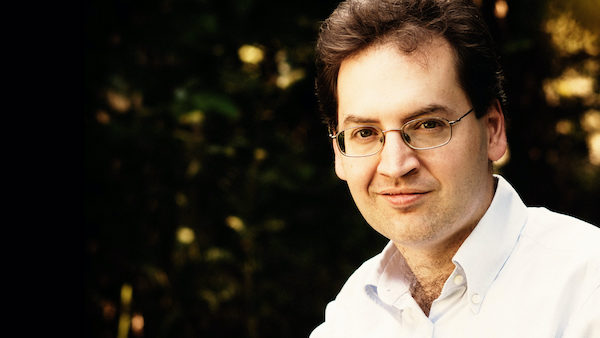Pianist Várjon brings freshness, probing depth to Candlelight program

Dénes Várjon performed a piano recital for Candlelight Concert Society Wednesday night in Columbia. Photo: Balazs Borocz
The coronavirus has not yet finished its disruptions, but the impact on the classical music world is becoming more of a nuisance than a threat.
Dénes Várjon had to cancel his March recital for Candlelight Concert Society after receiving a positive test. The Hungarian pianist, in the midst of an intense touring schedule, found the time to reschedule this event, and was heard Wednesday evening at Horowitz Performing Arts Center in Columbia.
As with his last area recital, with Washington Performing Arts in 2019, Várjon did not go far afield in his programming choices, sticking with music of the 18th and 19th centuries. Yet far from being staid or predictable, in Várjon’s hands these mostly familiar pieces found poetic expression that afforded the chance to appreciate them in new ways.
The pianist’s take on Bach’s English Suite No. 2 revealed the influence of historically informed performance style without any trace of pedantry. The sustaining pedal aided the legato touch at times, but copious ornamentation on repeats showed an awareness of baroque practice. Some of the more extravagant embellishments seemed modeled on the doubles, Bach’s written-out and lavishly embellished repeats, in two of the other suites in this collection.
Várjon’s Prelude contrasted softer solo episodes with the louder ritornello, a nod to the concerto grosso form Bach drew on in this movement. A more delicate touch gave the Allemande a contrasting intimacy, with a similar tone in the Sarabande, played for its expressive qualities without dragging out the tempo.
The paired Bourrées, on the other hand, went by so fast that there was little room to differentiate the Gigue with an even faster pacing. Or so one thought, until Várjon cranked up the tempo a notch in the unusual additional repeat of the entire Gigue indicated by Bach. As the dance whirled almost out of control, there were echoes of the descent into chaos depicted in Ravel’s La Valse.
Both halves of the recital ended with music of jaw-dropping virtuosity, first in Schumann’s Fantasie in C Major. Várjon, whose recordings of this composer’s music reveal his affinity for it, balanced the complex technical demands of the first and second movements with the moonlit fantasy of the melodies floating above them. The first movement’s closing tribute to Beethoven, a quotation from that composer’s song cycle An die ferne Geliebte, glowed ethereally.
The repeated main theme of the rondo middle movement crowed raucously, in later iterations with loudly hammered bass notes extending its broadness. Várjon moved rapidly through the thickets of dotted rhythms, in a sort of prancing wildness reminiscent of the triumphant marches of Schumann’s Davidsbündler, trampling down the Philistines. An unpredictable, whimsical rubato pacing, by contrast, animated the slow section.
Schumann’s decision to end this piece with a slow movement was a risk, but Várjon found a way to make it a convincing climax, beginning with the mysterious arpeggiation of chords harmonically related by thirds. Enigmatic harmonic shifts run throughout the movement as a trope, all handled with wide-eyed wonder, in spite of audience members noisily opening lozenge wrappers and allowing a cell phone to ring interminably.
Várjon had one more surprise up his sleeve for this movement: in the closing measures the Beethoven quotation that ended the first movement reappeared. This was Schumann’s original ending to the Fantasy, found notated but later crossed out in a handwritten score now in the Széchényi Library in Budapest. Some critical editions of the score include it as an alternate reading, and Várjon’s reinstatement of this lyrical passage was a final, authoritative touch.
Even the structure of the program had hidden scholarly appeal, with the first half’s pieces in the same key signature (A minor and C major), as well as the second half’s (D major and B minor). Mozart’s Rondo in D Major provided a moment of disarming simplicity, coming between two virtuosic monuments of the piano repertoire. Sixteenth-notes runs crystallized distinctly, with left-hand voicings adding numerous delightful shadings.
Várjon’s interpretation of Chopin’s Piano Sonata No. 3 emphasized romantic longing over steely virtuosity. Still, it was a performance accurate to the letter, down to the long repeat of the first movement’s exposition. The first movement had a dramatic sweep, complete with booming bass textures and dizzying chromatic runs in the left hand. The second movement danced with quicksilver wit, but always at the service of the melodic shape.
The Largo was another triumphant slow movement, recalling the conclusion of the Schumann piece, its arching themes clothed in a gauzy haze of sound. The aching sostenuto melody that appears in the E major middle section has never sounded so heartbreaking, flowing beautifully without any affectation. The fourth movement was more deliberate and angry, feeling more like bitter resolution than purely virtuosic showmanship.
Várjon’s choice of encore was no less surprising and apt. Bartók’s Three Hungarian Folksongs from the Csik District offered both a tribute to the pianist’s home country and an ideal palate cleanser with modal bite and improvisatory flourish.
Candlelight Concert Society presents cellist Steven Isserlis 3 p.m. June 5, with pianist Jeremy Denk at Linehan Concert Hall. candlelightconcerts.org
